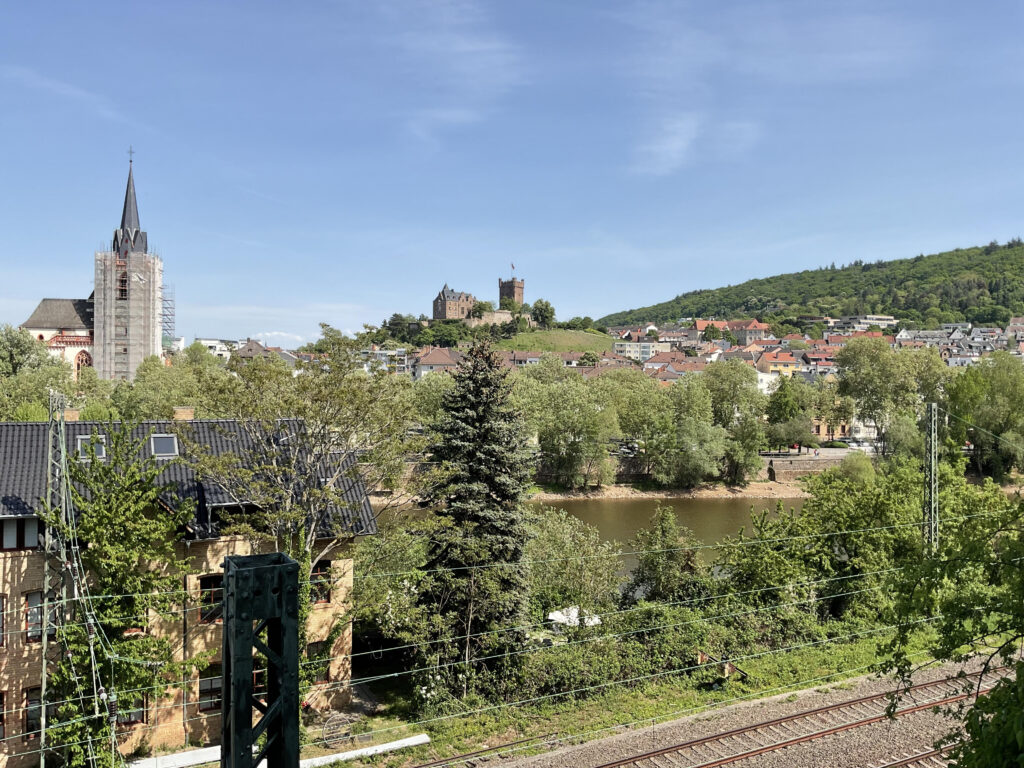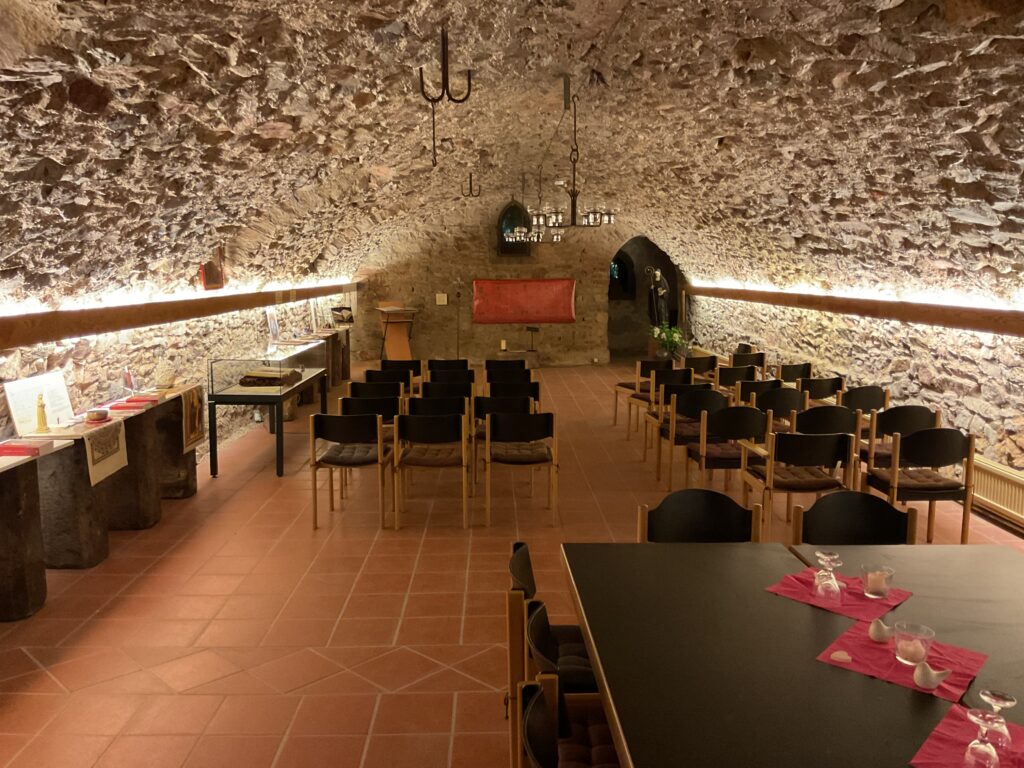There is nothing more exciting for an author than visiting the land through which her fictional characters travelled, a landscape that was real but that came out of the author’s imagination. At the same time, there is nothing more depressing than to discover that the 12th-century landscape you conjured is … well, let’s just say the imagination is rather more pastoral than the 21st-century reality!
Recently, I took a river boat cruise down the Rhine River. It was my first trip through Germany. I was particularly excited that one section of the Rhine would pass some of the places to which my characters travelled in A Flight of Saints. I was keen to see how my vivid imagination held up to the reality, and how the 12th-century image compared to the 21st-century one. I had even mapped out a mini excursion that would give me five “Hildegard moments”: the confluence of the Rhine and Nahe rivers where her convents were located; a visit to the last physical ruins of one of the convents; a visit to her shrine; a sighting of Worms Cathedral; and with luck a glimpse of Speyer.
Hildegard of Bingen was the great abbess of the 12th century; the iconoclast religious who argued with popes and emperors, who bravely preached in the town squares at a time when women were silenced. For the last three years I’ve been immersed in all things Hildegard as I worked on A Flight of Saints. Everything had lived in my head and now I had a chance to see the real thing, or rather the landscape where my novel takes place.
On the day we were due to sail past the sights, the sun was shining, the sky was blue. I was ready. I stood on the top deck, camera phone in hand. We were about to pass the point where the Rhine and Nahe rivers meet; the site where Hildegard built her two convents; the destination where my intrepid character Lucia and her friends would finally end their tortuous journey … when my phone battery inexplicably drained. No!! I could not resuscitate it. I was so focused on fixing the damn phone that I missed seeing the pivotal point with my own eyes. I missed the sight entirely. Disappointment doesn’t come close to describing how crushed I felt.
There was no time for tears, though. Our boat was docking in Rüdesheim am Rhine any minute, and my husband and I had five minutes to catch the ferry to Bingen. I could see it at its dock, passengers already marching aboard, and it was about a 10-minute walk away. We burst off the boat and ran for it.
“Go to the gangplank; I’ll get the tickets,” Colin said. I hadn’t run this fast for ages; I thought I might have a stroke.
We made it onboard with 30 seconds to spare. There wasn’t another boat for an hour, and by then we would have missed the appointment we had in Bingen. I was still stinging from my missed shot of the two rivers. My Hildegard experience was not going to plan.

Once again, no time for tears! When we disembarked in Bingen our next task was to find our way to where we were to meet someone from the Rupertsberg-Hildegard Society (RHS), a small organization valiantly preserving what little remains of Abbess Hildegard’s convent and to keep her spirit and legacy alive. The physical remains are the vaults, the cellars, and they’re only open to the public on Sundays. An exception had been made for us to see them that Friday.
Paper map in hand (my faith in technology having dissipated), we arrived in a car park. A large handsome building stood in front of us with the name Rupertsberg on it, but I knew it was not the old convent. Adjacent to it was a small strip mall: One had the signs Land der Hildegard (Land of Hildegard) and Rupertsberger Gewölbe (Rupertsberg Vault). Next door was a beauty and fashion salon. Well, Hildegard was all about hygiene and the importance of self-care so perhaps it was not an incongruous neighbour.
The day was hot, and there was little available shade from the sun. I was anxious about whether we were in the right place, and that I had got the day and time right. Relief arrived with the appearance of our guide Roswitha.
She started us in the large handsome building, now the town of Bingen’s archives. It was built on the ruins of the convent, and the RHS has done a valiant job of using small metal markers on the floor to map out the convent’s original footprint. There’s also a virtual reconstruction experience to give visitors a sense of what the convent would have looked like in the 12th and 13th centuries. This is open Tuesday to Friday in the afternoon.

Both of Hildegard’s convents, which faced each other across the Nahe River, were destroyed in the Thirty Years War (1618-1648). It was a vicious conflict that is frequently described as the most destructive war in European history. Up to eight million people died; some German towns saw three-quarters of their population wiped out. As with people, so with buildings: The war was triggered by the Reformation, and Hildegard’s convents, about 500 years old by then, stood little chance of survival.
Roswitha drew us to a window that looked across the Nahe toward medieval Klopp Castle, built fifty years after Hildegard’s death in 1179.
“Where you see the river, this convent once stretched right to the shore,” she said. “When the railway came to Bingen, the rock on which Rupertsberg Abbey stood was dynamited.” The blast exposed a Roman necropolis, as well as the 12th-century cellar vaults. Decades later, a fire on the site revealed the presence of 12th-century arches. Out of destruction comes evidence.
We went outside and crossed the small parking lot to the little strip mall. We entered modern glass doors into a tiled reception area, and made our way down the steps to the vaults. I felt the air cool considerably.
I’m not sure what I had expected but it wasn’t this. The vaulted ceiling and walls of rough stone are there; but the terracotta tiled floor is new, and the space is set up as a conference/reception venue with tables and chairs. It might work for a goth wedding.

Perhaps sensing my reaction, Roswitha was apologetic. “Yes, we must do this to pay for the upkeep of these ruins. This is the unfortunate result.”
As she spoke about the religious legacy of Hildegard, my eyes roamed the room and tried to push my imagination back 850 years wondering at the nuns, even Hildegard herself (she was reportedly a bit of a micro manager) who came down here to check on the stores of produce, meat, ale and wine. I ran my hands over the walls, wishing as we do when we touch something ancient to feel a flicker of the past.
We were just in time to catch the ferry back to Rüdesheim. Our Hildegard hunt was not over, and we made our way quickly through Rüdesheim to the parish church of St. Hildegard where the abbess’s shrine and relics are housed. I was more interested in seeing this than anything else. But when we arrived, the church doors were locked. There wasn’t anyone around.
There were further disappointments as we continued our journey down the Rhine. In A Flight of Saints, Lucia and company rest in front of Worms cathedral, which in 1179 was in the process of being built. From our boat, I saw the spires of Worms Cathedral in the distance, but as we drew closer the view was obliterated by old factories, junked cars, and what looked like a disused shunting yard. My heart sunk.

Finally, our boat was to pass Speyer, and I was eager to get a glimpse of the town where Lucia experienced her horrific tragedy. I was told by one of the tour managers that our boat would not pass Speyer until around midnight so I felt it was safe to sit down for dinner at 7pm. I was unaware that we were passing Speyer at that moment. Given the experiences of the last 24 hours, maybe it was for the best that I missed that too.
It’s a lesson about imagination. What we conjure in our mind’s eye is never going to be the reality. We romanticise the past – the recent and the ancient—but it’s unrealistic to not accept that it changes. Even something glimpsed last year, or last month, will have changed. I certainly didn’t expect Bingen or Worms to be as I imagined them circa 12th century, but I suppose I hoped there’d be a glimmer of it. That said, across the Rhine from Bingen, the undulating hills were exactly as I saw them in my mind.
There are numerous versions of what Hildegard’s convents looked like. I’ve included a few examples here. Are they fanciful imaginings, or are they based on stories passed down over the years, or are they somewhat true to life? Certainly the one of “Kloster Rupertsberg um 1600” could have been done prior to the Thirty Years War. I’d opt for that over the computer-generated image next to it. But who knows? I suppose at some point, we have no choice but to recreate the past and images that feel authentic to us.


